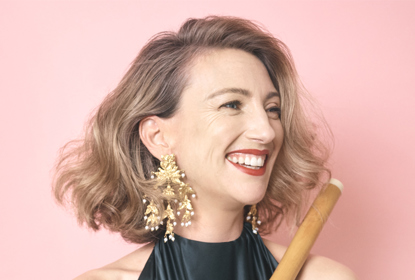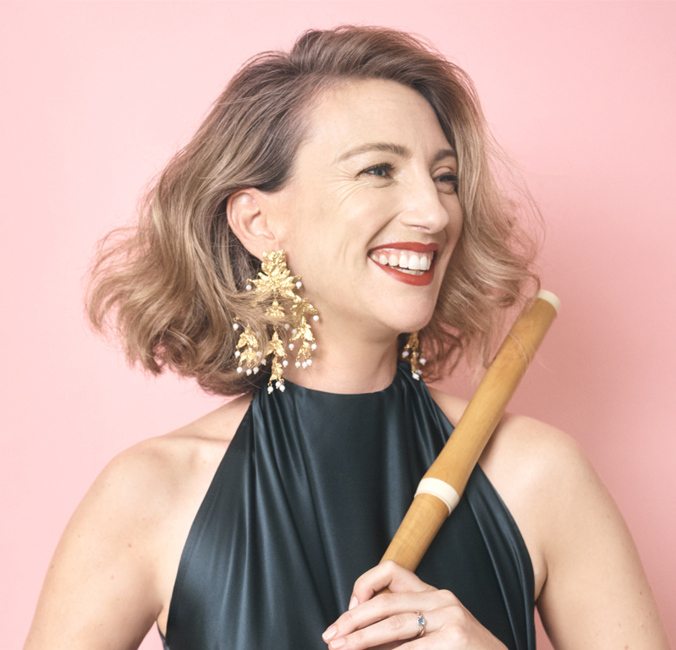Bach Series
Melissa Farrow Baroque Flute
BACH Nº 3
Melissa Farrow performs the Bourée Anglaise from JS Bach's Partita in A minor for solo flute, BWV 1013

PROGRAM NOTES
Johann Sebastian Bach (1685-1750)
PARTITA IN A MINOR, BWV 1013
Bourée Anglaise
‘Partita’ was originally the name for a solo instrumental piece of music in the sixteenth and seventeenth centuries. Various composers, including JS Bach, used the term for collections of musical pieces as a synonym for ‘Suite’. The root word is seemingly the Italian ‘parte’, meaning a ‘part’ or ‘section’.
While the Suite has movements in contrasting – though related – keys, a Partita remains true to its home tonality throughout. This is certainly the case with Bach’s Partita in A minor for solo flute. However, we do not know if JS Bach referred to this work as a Partita since no autograph manuscript survives. Indeed, the only copy from the period bears the name Solo p[our une] flûte traversière par J. S. Bach and, although unattributed, comes to us from the back of a manuscript copy of Bach’s Partitas and Sonatas for solo violin made by a very able pupil of Bach's, Bernhard Christian Kayser.
Principal Flautist of The Australian Brandenburg Orchestra, Melissa Farrow, has taken a long journey to come to this rendition of the only surviving piece by JS Bach for solo flute:
![]()
I first listened to the JS Bach Partita when I was a teenager, studied it and performed it on modern flute for my Senior Recital at the Con, way back in 1997.
Back then, playing on a silver flute, I took several masterclasses on how to interpret this masterpiece, blindly imitating the teachers’ advice to ‘even out’ everything musically and technically to sound crisp, bright and as perfect as possible. This was simply the typical modern flute approach back then to performing a well-known standard piece, Baroque or not.
These days, when approaching it from a HIP (Historically Informed Performance) perspective, and on a wooden replica one-keyed Baroque flute, I enjoy abandoning nearly everything I learned from the past, scrapping that weary approach for an attempt to breathe new life into this grand solo.
There are only a few solo pieces in the flute’s eighteenth-century repertoire, and so those that exist are played again and again. It feels both risky and exciting to pull the familiarity away and to explore a piece as for the very first time. It is a demanding but very rewarding process to attempt to ‘see’ something new in it and create individuality every time. The genius of the Partita, a collection of dances, lies in the fact that all the movements are connected in some way to each other, either motivically or rhythmically.
MELISSA FARROW
WHAT TO LISTEN FOR
With her wealth of performing experience, Melissa is the person best placed to share insights into this wonderful movement:
![]()
When approaching the Bourée Anglaise in preparation for the performance for Brandenburg One, I looked again into the meaning of the term. As the name suggests, it is an English Bourée, or English country dance (Contredanse), a term not often employed by Bach. These popular court dances were lighter and less formal than other dances.
I read recent articles and dissertations on the Partita, some that compare this movement with similar examples of Bourée anglaises, some suggesting that it really is making a bit of a mockery of itself. Witty features include the opening rhythm’s reversal of the regular Bourée rhythm and the second bar being an augmentation of the first bar, for example. I think Bach is having a bit of fun here - in a piece full of serious and tender A minor Affekt, he even spells his name B-A-C-H, slightly obscured yet floating on top in a top line in the middle of a contrapuntal passage.
I am often questioning how much (or if at all) the German composers which employed ‘mixed style’ into their writing at this time could have used inégale (or inequality) on their fastest notes to give a slight limping feel. I experimented here with the playfulness of the ‘Bourée in reverse’ tinged with a little inégale to try to create a sense of lightness and dance, in a movement that, to me, gives the impression that Bach writes with a little ‘twinkle in his eye’.
MELISSA FARROW
Program Notes: Joanna Butler & Hugh Ronzani, 2021
Image Credit: Katelyn-Jane Dunn, 2020
BACH SERIES PRESENTING PARTNER
Artists
Listen
{% error.message %}
More for you...
{% series.name %}
Featured Content
{% series.featuredTitle %}















